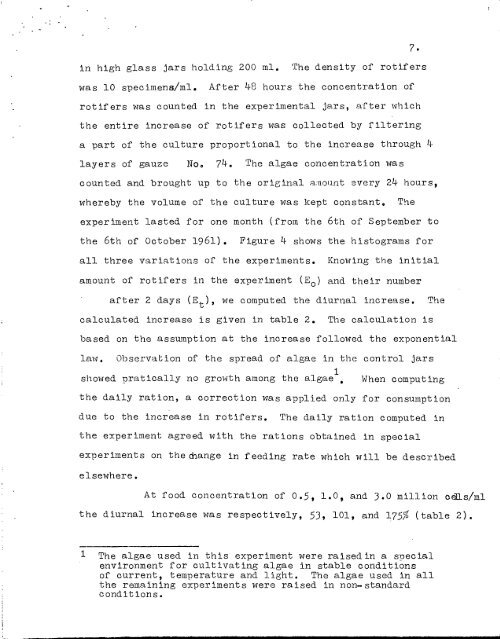Translation Series No.997
Translation Series No.997
Translation Series No.997
You also want an ePaper? Increase the reach of your titles
YUMPU automatically turns print PDFs into web optimized ePapers that Google loves.
7.<br />
in high glass jars holding 200 ml. The density of rotifers<br />
was 10 specimens/mi. After 48 hours the concentration of<br />
rotifers was counted in the experimental jars, after which<br />
the entire increase of rotifers was collected by filtering<br />
a part of the culture proportional to the increase through 4<br />
layers of gauze No, 74. The algae concentration was<br />
counted and brought up to the original altount every 24 hours,<br />
whereby the volume of the culture was kept constant, The<br />
experiment lasted for one month (from the 6th of September to<br />
the 6th of October 1961). Figure 4 shows the histograms for<br />
all three variations of the experiments. Knowing the initial<br />
amount of rotifers in the experiment (E 0 )<br />
and their number<br />
after 2 days (E t ), we computed the diurnal increase.<br />
calculated increase is given in table 2.<br />
The calculation is<br />
based on the assumption at the increase followed the exponential<br />
law . Observation of the spread of algae in the control jars<br />
showed uratically no growth among the algae 1 When computing<br />
the daily ration, a correction was applied only for consumption<br />
The<br />
due to the increase in rotifers.<br />
The daily ration computed in<br />
the experiment agreed with the rations obtained in special<br />
experiments on the change in feeding rate which will be described<br />
elsewhere.<br />
At food concentration of 0.5, 1.0, and 3.0 million cd1s/m1<br />
the diurnal increase was respectively, 53, 101, and 175% (table 2).<br />
1 The algae used in this experiment were raisedin a suecial<br />
environment for cultivating algae in stable conditions<br />
of current, temperature and light. The algae used in all<br />
the remaining experiments were raised in non-standard<br />
conditions.
















